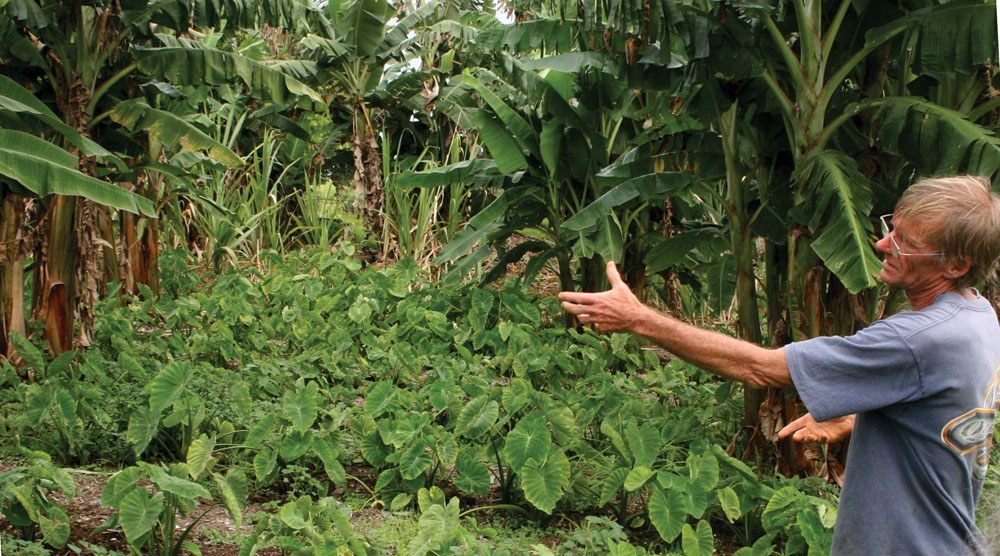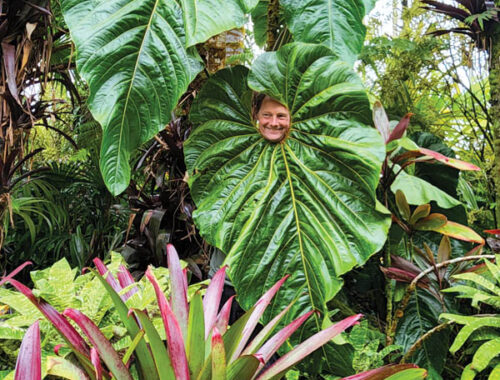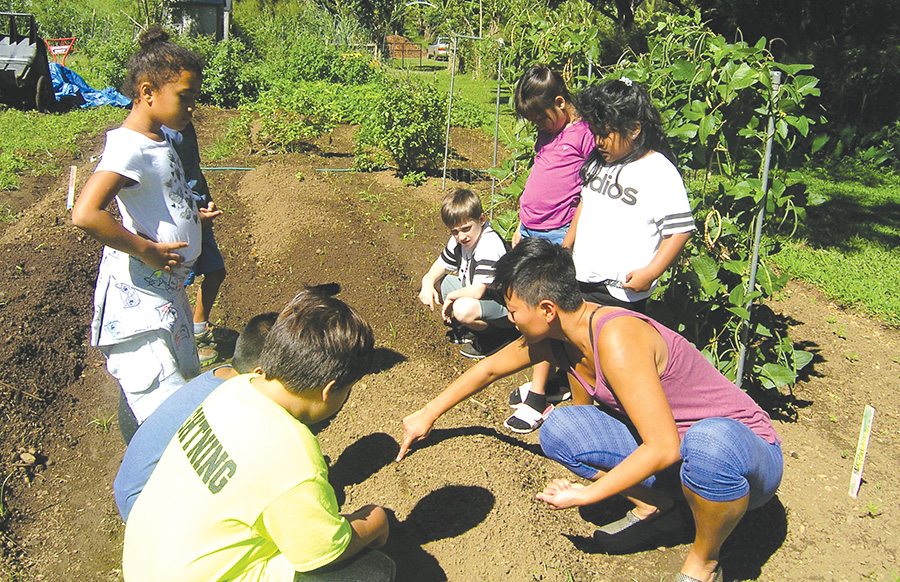
Lessons from the Garden

By Jan Wizinowich
The Hawaiʽi Island School Garden Network (HISGN) was created in 2007 through The Kohala Center as a way to promote garden education and food sustainability practices. As the network grew, educators began to realize the potential for course connections. In 2016 the HISGN received funding to develop a curriculum map, which was created by a consortium of K–8 school garden educators, led by Nancy Redfeather, Ming Wei Koh and Amanda Rieux, Malaʽai Culinary Garden Director.
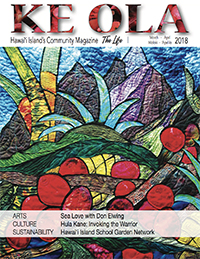
“It’s not a curriculum. It’s a curriculum map. It’s not a set of lessons at all. We started out with the basic question: what do we ideally want an 8th grader to know if they spent their career as schoolchildren learning in the garden. We went through by grade level to see what the learning outcomes were and the garden activities that go with them and then we looked at classroom extensions. We came up with four themes or lenses: sense of place, living plants and living soils, nourishment, and nature’s design,” said Amanda.
Now 60 strong, the gardens have become intrinsic to school curriculums, providing unique lessons from the processes that are the foundations for life. Also, with grounding in Hawaiian cultural practices, school gardens have created a path back to the source for students, educators and community members on Hawaiʽi Island.
In the Kohala district, school gardens range from a series of wood-framed raised beds such as at Kanu o ka ʽĀina, to a full garden space such as at Malaʽai Culinary Garden and Kohala Elementary to Parker School’s food forest.
Kanu o ka ʽĀina
The school garden at Kanu is really a series of gardens that are connected to each of the grade level classrooms. The school garden coordinator, Heather Sarsona, meets me in front of the school and we walk down to the makai (ocean-side) end of the building. “This is our preschool garden and outdoor learning space. Anna Peach is our garden teacher for the preschool. Right now we’re planting buckwheat and beans to amend the soil,” said Heather.
We move on to the next garden area. When Makali‘i sails to Papahānaumokuākea in two years, they will be carrying supplies grown in the Kanu garden. “This is a developing tea garden area. We have mamake, lemon verbana, African hibiscus, lemon mamake, lavender, lemongrass, and ‘ōlena (turmeric). The teas are one of the things we’re going to contribute to the voyage,” said Heather. “Each hui (group) is going to look at what they grow best and learn how to process it.”
The garden boxes contain a range of plants such as kalo (taro), lettuce, tomatoes, herbs, squash, corn, and pumpkins. “We grow a lot of pumpkins and that’s another thing we’re going to contribute to the voyage,” said Heather.
All the classrooms open to the garden space and there is a sense of continuous flow between indoor and outdoor learning environments, complete with a gathering place for stories and a kōnane (Hawaiian checkers) board.

Malaʽai Culinary Garden
Bordered by Waimea Middle School’s new science building and playground, Malaʽai Culinary Garden is ideally located in the heart of old Waimea. Besides garden director Amanda, the garden has executive director Alethea Lai and full-time garden leader, Holly Sargent-Green, who sees every student at least every two weeks.
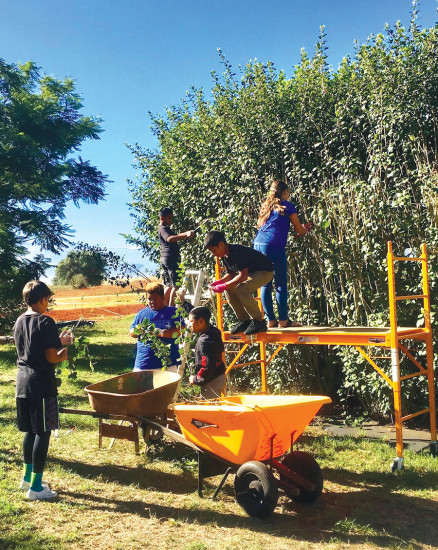
The garden provides a holistic learning environment that connects with the kind of learning that takes place in the classroom. “We have a really long-term, solid partnership with our science teachers. The garden is a lens that connects students to the living world, which connects them to all living worlds,” explains Amanda.
Students participate in all aspects of garden life while at the same time gaining a deep understanding of the underlying biological processes at work. Starting in kindergarten, students are observing, collecting data and developing a keen sense of place.
A favorite saying of Pwo Navigator Chadd Paishon is, “Know your island and you will never be lost.” Beyond the science, the garden experience helps students develop a personal compass that will guide them throughout their life journeys.
“As they are growing they have a relationship with this place. There’s a personal, private relationship that grounds them. Their actions, their work over time is really important. That sense of place and feeling, like they are real contributors. That’s where it becomes very powerful,” said Amanda.
Kohala Elementary School Garden
To find your way to the Kohala Elementary School garden you follow a path along an array of terraced classrooms and then suddenly off to the left you see a koa-lined, downward, zigzagging path to an Eden-like valley.
A group of second graders pause at the top to chant and ask permission to enter, leaving any disturbances behind. “A while ago I created a trouble tree. However you’re feeling affects the plants, so you shouldn’t walk into the garden feeling angry or sad. We toss all that to the trouble tree,” said Kayla Sinotte, the garden coordinator for Kohala Elementary School.

Each class has its own garden bed with varying themes such as seeds and lifecycles, nutrition, compost, soil and native Hawaiian plants. “The older classes have themes such as Mediterranean, bodybuilding and they choose plants according to their use and companion planting. Then they harvest whatever they grow and make something,” said Kayla. “The connection to the land; I think it’s really important for kids to know where they’re from and where their food comes from,” she added.
This year’s full-time Food Corps teacher, June Guo, gathers students at a table to examine the carrot seeds they will be planting today. “What happens when seeds get water and sunlight?” June asks. “They break and you give them more water and they sprout,” answers one of the students.
June goes on to explain why they will be planting the seeds directly into the ground, rather than starting them in pots and then it’s off to their particular raised bed to plant. “We incorporate science into the lessons but we also give them the opportunity to get their hands dirty. There’s a living curriculum that’s inspired by all these garden resources we have. What is happening in our garden? What’s happening at our school? What cultural activities are going on?”
Garden lessons also stretch out to other parts of the students’ lives. “Parents have come up to me and made comments like: ‘I don’t know what you do in the garden but now my kid is helping me in mine. And he asked me for kale. What did you do to get him to like kale?’” said Kayla.
Parker School Garden
The Parker School garden is located on the north side of Waikoloa Stream, running through the center of town. Today’s session for middle school science students begins in the classroom where their garden teacher, Jared Chapman, is having students write and reflect on six principles promoted through work in the garden: hoʽokuanoʽo (complex thinker), hana noeʽau (quality producer), mālama kaiāulu (community contributor), kūpono hana ‘ike (effective user of technology), kuleana i hola (self-directed learner), kaka ‘ōlelo (effective communicator).

On the way to the garden, students stop to form a line facing Maunakea and chant Mālana Mai Kaʽū (Buoyant Comes Kaʽū). We enter the garden, a veritable food forest with paths that meander through a treasure trove of native plants. “This area in general used to be ancient farms. If you walk the stream you can see where the old ʽauwai (canal) was built. This whole area was agriculture and now we’re bringing it back,” said Jared.
Observing and nurturing potted plants is the first order of the day. “Look, it’s like a raincoat,” said one student observing a bead of water dancing on a kalo leaf. Students then disappear into the forest, harvesting mamake and weeding around trees.
Students are constantly grappling with the complexities of life and the garden is rich with informative metaphors. “When you’re doing a school garden, you have that unique opportunity to focus on diversity. Once they’re working, they’re seeing things around them and the lessons come, regardless of what I tell them,” said Jared.
Parker School science and Hawaiian studies teacher, Susan Rickards incorporates the garden in a range of classes she teaches at Parker School. “What’s more tangible than the garden? It ties into all of the classes, especially the Hawaiian studies class. As far as the historical curricula, we go to the garden and investigate which of these, if any, existed pre-human or pre-mammal even, pre-invasive species, pre-canoe,” said Susan. “Then we learn about a particular species, plant it and see how it grows. We tie that intimately with the culture and traditions,” she added.
Community Connections
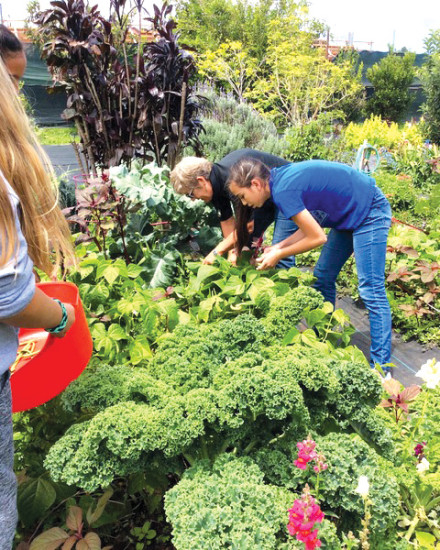
The Kohala school gardens have developed strong mutual relationships with their communities. “We couldn’t run our program without our community volunteers. We have four community members that come and work in the garden with our classes. It allows us to have small group sizes and it gives us the opportunity to go deep into subject matter,” said Holly.
The Kohala Elementary School garden has made a connection with local businesses. “We sell our mint, basil, parsley, and dill to Sushi Rock/Trio Restaurant and kale and eggplant to the Kohala Coffee Mill,” said Kayla. “We also sell our taro leaves to CSC Café, right across the street. The kids bring their families in and order the laulau plate and they can say, ‘I grew that’,” she added.
Like the Hōkūle‘a, Kohala gardens have the potential to make global connections. “We just had a group come from Amsterdam. They came to the garden and did a workday and met with the Ike Hawaiʽi students. It was great,” said Holly.
Gardens are living metaphors that promote health and peace and the Kohala school gardens are a shining example of the waʽa (canoe) spirit that permeates our island. ❖
“He waʽa, he moku. He moku he waʽa.”
(The canoe is our island, and the island is our canoe.)
—Clay Bertelmann
For more information: kohalacenter.org/hisgn, malaai.org/
Mahalo Island Naturals – Local Agriculture Story Sponsor

